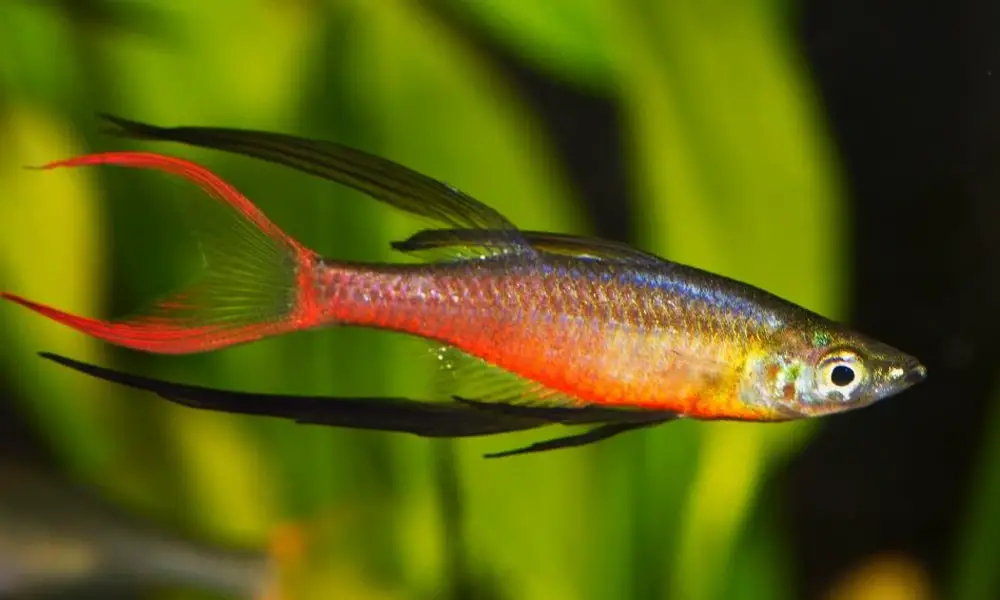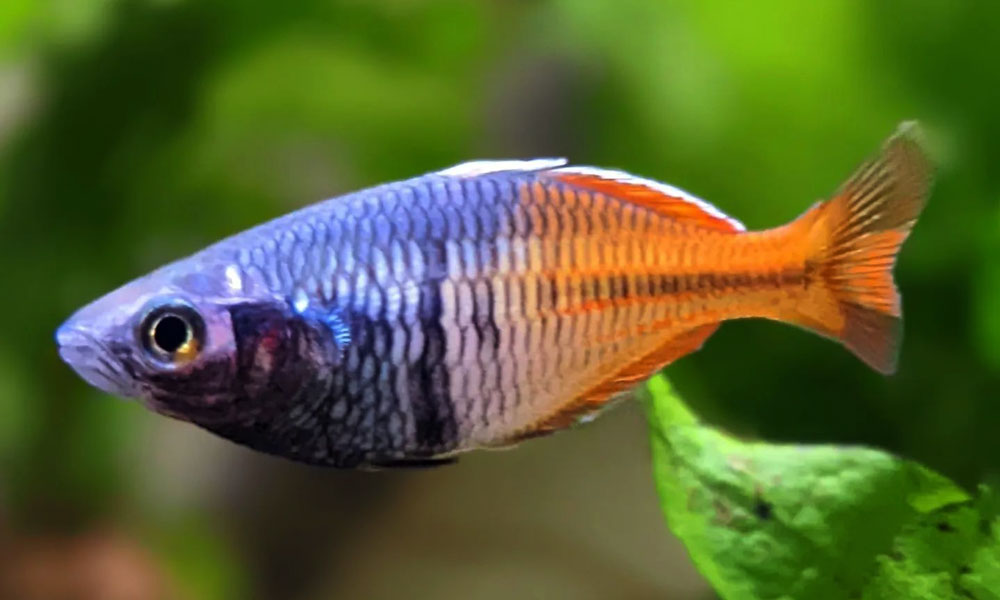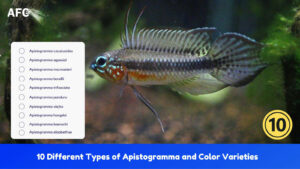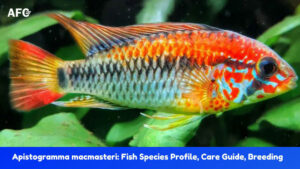If you’re looking for flashy, colorful fish to add some excitement to your nano or planted aquarium, look no further than small rainbowfish! These little guys are sure to brighten up any aquarium.
But while the vast number of colors and patterns available can be quite stunning. Stocking them with other fish can also be a bit tricky when you’re standing in the local fish store thinking about bringing one or two species to your new tank.
That’s why we put together this list of the most popular small rainbowfish to help you out. In it, we’ll go over some small rainbow fish with specie profile and what you need to know to keep them healthy and happy.
So without further ado, here are ten of the most colorful small rainbow fish to consider adding to your collection. Good luck narrowing it down to get one or more!
Dwarf Neon Rainbowfish (Melanotaenia praecox)

We’re starting off our list with one of the well-known dwarf rainbowfish.
The Dwarf Neon Rainbowfish, also known as Dwarf Rainbowfish, is one of the smallest rainbowfish in the trade. This fish only reach up to 2 – 2.5 inches in length.
As its name suggests, the Neon Dwarf Rainbowfish is known for its beautiful neon blue tones, ranging from lavender to turquoise, when lighting hits them from the front.
It is an active, peaceful community fish that does well in loose groups of 6 or more of their own kind. However, these fish are not recommended for beginners since they are quite delicate and require very specific water conditions to thrive.
| Scientific Name: | Melanotaenia praecox |
| Common Name: | Neon Dwarf Rainbowfish |
| Origin: | Southeast Asia |
| Max Size: | 2 to 2.5 inches |
| pH: | 6.8-7.5 |
| Temperature: | 73-82°F (23-28°C) |
| KH: | 5-15 dKH |
| Diet: | Omnivorous |
Spotted Blue-Eyed Rainbowfish (Pseudomugil gertrudae)

The Spotted Blue Eye Dwarf Rainbowfish is one of the less-known variants of the Blue Eye Rainbowfish and hails from northern Australia, Indonesia, and New Guiniea.
This fish is a beautiful species that has a unique appearance with amazing and vibrant light yellow with black spots. They get their name from the attractive ringed blue eyes, giving them a very sweet and endearing look.
Since these fish stay small, they do best in schooling groups of 10 or more of their own kind. They are an active swimming species that prefer plenty of open space to swim in their aquarium.
Furthermore, Gertrude’s Spotted Blue Eye Rainbowfish is peaceful and hardy, and you can keep them with adult dwarf shrimp and non-aggressive invertebrates in a small community tank.
| Scientific Name: | Pseudomugil gertrudae |
| Common Name: | Spotted Blue-Eyed Rainbowfish |
| Origin: | Indonesia, New Guinea, Northern Australia |
| Max Size: | 1.5 inches |
| pH: | 4.5 – 7.5 |
| Temperature: | 72° – 82° F (22° – 28° C) |
| KH: | 12 – 15 dKH |
| Diet: | Omnivorous |
Red Neon Blue Eye Rainbowfish (Pseudomugil luminatus)
Red neon blue-eye Rainbowfish, the cousin of the Spotted Blue Eye Rainbowfish, is another sought-after, vibrantly colored dwarf rainbowfish.
This small fish is a real stunner with beautiful blue eyes and a brilliant red neon body. Males, in particular, are very colorful, and their second dorsal and anal fins tend to be longer and more flowing than females.
In their natural habits, they live in large schools with heavy vegetation, plus their smaller full-grown size (1.5 inches), making them the perfect candidate for nano aquariums or small planted tanks with the cover of floating plants.
This species is a shoaling fish, so they do best in groups of as many as possible. They are a very peaceful species that can be kept with small shrimp and other non-aggressive tankmates.
| Scientific Name: | Pseudomugil luminatus |
| Common Name: | Red Neon Blue Eye Rainbowfish |
| Origin: | Indonesia, New Guinea, Northern Australia |
| Max Size: | 1.5 inches |
| pH: | 6.5 – 7.5 |
| Temperature: | 64.4° – 78.8° F (18° – 26° C) |
| KH: | 12 – 15 dKH |
| Diet: | Omnivorous |
Forktailed Rainbowfish (Pseudomugil furcatus)

Also known as the Blue-Eyed Forktail or Furcata Rainbowfish, the Forktailed Rainbowfish comes from the same genus Pseudomugil as the previous two small rainbowfish on our list.
When it comes to aesthetics, it’s hard to beat the Forktailed Rainbowfish. Males are quite stunning, with beautiful glowing blue eyes and small and subdued dorsal fringed in black and yellow. Their bodies are simple torpedo-shaped that are colored with a silver-gray base accompanying a greenish tint.
This small species only reach a maximum size of 2.5 inches (6.5 cm) when fully grown, making them an ideal candidate for small planted nano aquariums. They are a peaceful and social species that do best in groups of 6 or more of their own kind.
| Scientific Name: | Pseudomugil furcatus |
| Common Name: | Forktailed Rainbowfish, Blue-Eyed Forktail |
| Origin: | New Guinea |
| Max Size: | 2 inches |
| pH: | 6.0 to 8.0 |
| Temperature: | 75–80°F (24–27°C) |
| KH: | 5- 12 dKH |
| Diet: | Omnivorous |
Threadfin Rainbowfish (Iriatherina werneri)

This is a really interesting rainbowfish species that deserves its own spot among hobbyists.
What makes them stand out is their unique body shapes and beautiful long fins that give them an elegant look. The caudal fin on a male can grow up to twice the size of the female and have a bright red hue with vertical stripes that is really stunning to see.
Despite their small size, these fish are shoaling swimmers by nature and should be kept in small groups of 10 or more individuals.
Threadfin Rainbowfish is peaceful but not a good candidate for the general community aquarium as it’s easily out-competed for food, and its long fins make it an easy target for fin nippers.
| Scientific Name: | Iriatherina werneri |
| Common Name: | Threadfin Rainbowfish |
| Origin: | Indonesia, New Guinea, Northern Australia |
| Max Size: | 2 inches |
| pH: | 5.5 to 7.5 |
| Temperature: | 73.0 to 84.0° F (22.8 to 28.9° C) |
| KH: | 5- 19 dKH |
| Diet: | Omnivorous |
Celebes Rainbowfish (Telmatherina ladigesi)

The Celebes Rainbowfish is one of our all-time favorite species owing to its pretty coloration and small size. These fish only reach a maximum length of 3 inches, making them one of the smaller species available.
They have a lovely iridescent yellow and blue coloration with a neon line that starts half the fish and runs horizontally along the slender body. Like the Threadfin Rainbowfish, colorful males develop an extended second dorsal and anal fin.
This species is also a schooling fish that does best in small groups of 6 or more fish. Males should be kept with 2-3 females to get the most color. They are peaceful by nature and make great community fish, but be careful with these fin nippers.
| Scientific Name: | Telmatherina ladigesi |
| Common Name: | Celebes Rainbowfish |
| Origin: | Indonesia |
| Max Size: | 3.2 inches |
| pH: | 7.0 to 8.0 |
| Temperature: | 72-82°F (22-28°C) |
| KH: | 10 – 25 dKH |
| Diet: | Omnivorous |
Boesemani Rainbowfish (Melanotaenia boesemani)

The Boesemani Rainbowfish has quite a well-earned reputation for its almost unreal coloration, which can create a colorful centerpiece in any aquarium.
These fish are small to medium in size, reaching a maximum length of about 4.5 inches (11.43 cm). When mature, males show distinct color patterns with deep blue or purple in the front half and bright orange and yellow in the back half of their body, giving them a stunning look.
This peaceful Rainbow is a schooling species that do best in small groups of at least 6 or more of their own kind with an equal male-to-female ratio. This will promote better coloration in both males and females and help reduce aggression.
As with most rainbow fish, Boesemanis are excellent fish for beginners. They are hardy and very active swimmers that do well in a variety of different large aquariums.
| Scientific Name: | Melanotaenia boesemani |
| Common Name: | Boesemani Rainbowfish |
| Origin: | Indonesia |
| Max Size: | 5 inches |
| pH: | 7.0 to 8.0 |
| Temperature: | 81-86°F (27-30°C) |
| KH: | 10 – 20dKH |
| Diet: | Omnivorous |
Desert Rainbowfish (Melanotaenia splendida tatei)

In my opinion, the Desert Rainbowfish is a very underrated species for a “rainbow” fish. Compared to the above species, the Desert Rainbowfish is a little less colorful. However, a smart aquarium setup with a black background and substrate gives these fish a chance to show their real beauty.
The Desert Rainbowfish is a medium-sized fish that reaches about 4 inches (10 cm) in length. They are silver in color with shiny blue and yellow scales on their body. The fins are clear with a hint of blue, making them very pretty.
These fish are not common in the hobby outside of Australia and are only sold at a moderate price through specialized breeders. The good news is they are so well adapted to various water conditions that they are very easy to care for under even more extreme weather conditions.
| Scientific Name: | Melanotaenia splendida tatei |
| Common Name: | Desert Rainbowfish |
| Origin: | Australia |
| Max Size: | 4 inches |
| pH: | 7.2 to 8.0 |
| Temperature: | 75-86°F (24-30°C) |
| KH: | 10 – 30 dKH |
| Diet: | Omnivorous |
Yellow Rainbowfish (Melanotaenia herbertaxelrodi)
The Yellow Rainbowfish is endemic to the Lake Tebera basin in Papua New Guinea. They have a yellow body, accompanying a darker line that extends from the snout, through the eye, and to the base of the tail. This yellow coloration on young fish is unbelievably vibrant, while the adults tend to be a little more yellow-green. Adult males are much more colorful.
In the wild, they are found in small creeks and streams, where they congregate around the vegetation. In the aquarium, they enjoy eating duckweed – the smallest flowering floating plant.
Most rainbowfish show their best colors at sunrise when the sun first hits the water. The colors of the males are more intense for potential mates. Therefore, having more females than males in the aquarium will allow you to see the colors of all your fish more often. Furthermore, it helps to avoid any aggression toward females.
They are peaceful community fish that should be kept in groups of 6 or more fish. A single male with 2-3 females is a good ratio to promote coloration in both sexes.
| Scientific Name: | Melanotaenia herbertaxelrodi |
| Common Name: | Yellow Rainbowfish |
| Origin: | New Guinea |
| Max Size: | 4 inches |
| pH: | 7.0 to 8.0 |
| Temperature: | 68-79°F (20-26°C) |
| KH: | 10 – 15 dKH |
| Diet: | Omnivorous |
Lake Wanam Rainbowfish (Glossolepis wanamensis)

The Lake Wanam Rainbowfish, sometimes referred to as emerald rainbowfish, is named for its origin – the Lake Wanam in Papua New Guinea.
This species is known for its greenish base with a yellowish patch on the belly. The colors of this fish’s scales are very interesting. They start out orange and become bluish towards the tail, making for a vibrant-looking creature!
Since these are schooling fish, you’ll need to purchase at least 6 in order to properly take care of them, but I recommend you get even more. The more the merrier when it comes to these guys – not only will they be happier, but you’ll also see their colors better when they’re in a large group.
| Scientific Name: | Glossolepis wanamensis |
| Common Name: | Lake Wanam Rainbowfish, emerald rainbowfish |
| Origin: | Lake Wanam, Papua New Guinea. |
| Max Size: | 4 inches |
| pH: | 7.0 to 8.0 |
| Temperature: | 77-86°F (25-30°C) |
| KH: | 10 – 20 dKH |
| Diet: | Omnivorous |
Time To Hit The Store!
Well, that’s the end of our list! We hope you enjoyed learning about these small rainbowfish and found at least one that piqued your interest. While they might not be as flashy as some of their larger cousins, these little fish are full of personality and can make a superb addition to any nano or planted aquarium!
If there are any colorful fish you think we missed, let us know down in the comments! We love to hear from you.






2 thoughts on “10 Best Small Rainbowfish For Nano Aquarium (With Pictures)”
The picture for the profile of the Lake Wanam Rainbowfish, is incorrect. That looks like a picture of a Melanotaenia trifasciata or Regal Rainbowfish. Also, the profile incorrectly states that the, “The Lake Kutubu Rainbowfish, sometimes referred to as emerald rainbowfish, is named for its origin – the Lake Kutubu in Papua New Guinea.” The Lake Kutubu Rainbowfish is actually a different species: Melanotaenia lacustris, which is best known as the Turquoise Rainbowfish. It’s a beautiful fish, and it’s one of the most popular types of rainbowfish in the hobby.
Hi Josh
I wanted to take a moment to thank you for bringing an error in our article to our attention. We take the accuracy of our content very seriously and appreciate you taking the time to point out the mistake.
We have reviewed the error and have made the necessary corrections to ensure that the information in our article is accurate and up-to-date. We apologize for any confusion or inconvenience that the error may have caused.
Thank you again for your attention to detail and for helping us improve the quality of our content. We value your feedback and appreciate your support.
Best,
Jeff